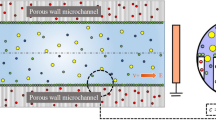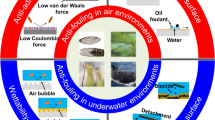Abstract
An electromagnetic anti-fouling technology (EAFT) was developed further. The operating principle of the EAFT was presented using fundamental physics laws. To validate the effect of EAFT and identify the mechanism, a circulating flow setup was built. A series of fouling tests were carried out with and without EAFT, measuring fouling thermal resistance as function of time, making scanning electron microscope images and analyzing the particles size distribution in solution by dynamics light scattering technology. The main results were as follows: 1) All the precipitated crystals in solution were calcite and there were little differences between with EAFT and without EAFT in the experimental range. 2) The number of precipitate nucleation in solution was small and the particle growth was slow without EAFT. In opposition to the case untreated, a rapid particle growth was observed and the number of nucleation was expected to be large, due to the fact that the EAFT effectively increases the ions and crystals collision frequency and effectiveness by utilizing the induced electric field. It is indicated that the particle growth is promoted mainly by coagulation process but not nucleation growth. 3) The EAFT could prolong the delay time of fouling greatly, and after the delay time, the thermal resistance quickly increased. Therefore, in order to mitigate scale significantly, the floccules in solution should be deposited beforehand in a low-lying area of the exchangers and let off in time.
Similar content being viewed by others
References
Taborek J, Knudsen J G, Aoki T, et al. Fouling: the major unresolved problem in heat transfer (I): fouling mechanisms, their characteristics and factors influencing them[J]. Chemical Engineering Progress, 1972, 68(2) 59–67.
Suitor J W, Marner W J, Ritter R B. The history and status of research in fouling of heat exchangers in cooling water services[J]. Canadian J Chem Eng, 1977, 55: 374–380.
Knudsen J G. Cooling water fouling—A brief review, fouling in heat exchanger equipment[C]. 20th ASME/AICHE Heat Transfer Conference. New York: Hemisphere Publishing Corporation, 1981, 17: 29–38.
Hasson D, Avriel M, Resnick W, et al. Mechanism of calcium carbonate scale deposition on heat transfer surfaces[J]. Ind Eng Chem Fund, 1968, 7(1): 59–65.
Watkinson A P, Louis L, Brent R. Scaling of enhanced heat exchanger tube[J]. Canadian J Chem Eng, 1974, 52: 558–562.
Linke W F. Solubilities-inorganic and Metal Organic Compounds[M]. Princeton: VanNostrand Company Inc, 1958.
Branch C A, Müller-Steinhagen H. Influence of scaling on the performance of shell-and-tube heat exchangers[J]. Heat Transfer Engineering, 1991, 12: 37–45.
Munson B R, Young D F, Okiishi T H. Fundamentals of Fluid Mechanics[M]. New York: Wiley, 1994.
FAN Chun-fu. A Study of Electronic Descaling Technology to Control Precipitation Fouling[D]. Philadelphia: Drexel University, 1997.
Choi B G. A Study of Fouling Control in Heat Exchangers with Electronic Anti-fouling Technology [D]. Philadelphia: Drexel University, 1998.
LIU Rong. A Study of Fouling in a Heat Exchanger with an Application of an Electronic Anti-fouling Technology[D]. Philadelphia: Drexel University, 1999.
Kim Won tae. A Study of Physical Water Treatment Methods for the Mitigation of Mineral Fouling[D]. Philadelphia: Drexel University, 2001.
Lee Sung H. A study of Physical Water Treatment Technology to Mitigate the Mineral Fouling in Heat Exchanger [D]. Philadelphia: Drexel University, 2002.
Cowan D J. Water-formed Scale Deposits[M]. Houston: Gulf Publishing Company, 1976.
Troup J A. Scale nucleation on a heat transfer surface and its prevention[J]. Chem Eng Comm, 1978(2): 167–180.
Author information
Authors and Affiliations
Corresponding author
Additional information
Foundation item: Project (G2000026304) supported by the National Key Fundamental Research and Development Program of China
Rights and permissions
About this article
Cite this article
Xing, Xk., Ma, Cf., Chen, Yc. et al. Electromagnetic anti-fouling technology for prevention of scale. J Cent. South Univ. Technol. 13, 68–74 (2006). https://doi.org/10.1007/s11771-006-0109-2
Received:
Accepted:
Published:
Issue Date:
DOI: https://doi.org/10.1007/s11771-006-0109-2




